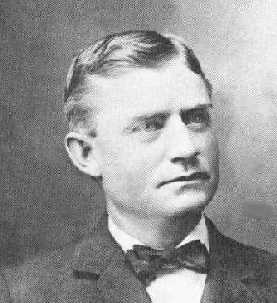HISTORIC WALLACE PERSONALITIES
May Arkwright Hutton
[The following is borrowed very largely from James W. Montgomery's Liberated Woman: a life of May Arkwright Hutton (Spokane: Gingko House Publishers, 1974), from which photos have also been borrowed, permission pending.]
For
sheer bravado or, for that matter, boundless compassion,
no figure in Wallace's
colorful history outshines May Arkwright
Hutton (1860-1915).
Pair her in your mind with Denver's "unsinkable" Molly Brown, May's better
known historical contemporary, and you'll have the outline of a bold form
that Western womanhood could sometimes take. Like Molly, May was
born and grew up in the Midwest -- in Mahoning County, Ohio -- the offspring
of the second marriage of Isaac Arkwright, a father undisposed toward parenthood,
and a mother (whose name history does not record) who reportedly abandoned
May early on by going "over the line" into neighboring Pennsylvania.1
May had no memory of either parent in her adult years. She was raised
to age 10 by her aged and blind Grandpa Arkwright. Childhood was
not separated from adult responsibilities by a leisurely stretch of protected
adolescence in the 19th century, and May's worklife and independence began
at this tender age and as soon as she could be made use of.
May became a big-boned, large-scale woman, as plain as she was confident and plainspoken. In June of 1882, at age 22, she married Bert Munn, a hardworking stable boss and mule driver at a local coal mine. Before long, Bert disappeared and May made plans to head west to make her fortune in the Coeur d'Alenes of "Idyho." She set out with an entourage of some forty coal miners whose dreams of freedom and riches had also been fired by the recent news of new gold strikes in the Bitterroot mountains along the North Fork of the Coeur d'Alene River.
Out West at Last
She arrived in this region in 1883 or 1884, landing first in the North Fork towns of Eagle City or Murray. But with reports of the discovery of a rich stripe of galena by Phil O'Rourke and Noah S. Kellogg along the South Fork in 1885, May moved and took a job as waitress in Wardern camp (fromerly known as "Kentuck") in a restaurant owned by Charley Rice. When May learned in 1886 that a narrow gauge railroad was going to be built from Mission dock eastward, she shrewdly found out where the track was going to be laid and opened her own eatery at Wardner Junction (now Kellogg). She bought "a cow, a broom, a bucket, a cookstove, a piece of land and a two room shack. In the front room she put her oil cloth covered table and the stove; the back room was here sleeping quarters which she separated from the 'restaurant' with a calico curtain."2

Early image of Wardner Junction, cropped from a
larger shot and brightened. Montgomery
wrote
that "one of the buildings in the foreground near
the tracks was occupied by May's restaurant"
(p. 26).
May's restaurant was launched
in a transitional moment in local history. Montgomery wrote eloquently
of the contemporaneous downturn in spirits and heart of the miners May
knew after her move from the North to the South Fork:
- [The North Fork] was a land of neurotics,
eccentrics, thieves, gyps, whores, tramps; of dreamers, workers, planners--a
land of people. But after May had moved...and after the first great
claims were filed, a different atmosphere prevailed. The great good
fun of an individual's success, the honest one man against the wilderness
fight, the contest of a single soul against incalculable odds was somehow
no longer very important. A dehumanizing factor had silently, unobtrusively
entered the valley like the black damp....The excited talk that followed
her rich desserts died out (p. 27).
- Throughout her life May was willing
to involve herself in the plight of the working man. She saw him
in his need whether he was a shortskaker in the mines, a bindle stiff in
the logging camps, or a hired man on the wheat farms. Because she
was as emotionally solid as she appeared physically solid at two hundred
and fifty pounds, shw was able to relate to these meandering spirits, unappreciated,
unrecognized, often twistred of mind and broken of body....She saw how
shallow and how dearly bouth was the freedom they cherished. This
liberty hansomely provided by the loosed society of the West was squandered
in one long Saturday night drunk of wase and indifference, and most striking
of all it was lost through impatience. The 'shortstaker' was a name
given to a miner who worked for ten days then groveled in saloons till
his money gave and forced him to work another 'short stake.' Patience
this man had not. Not for him was the long summer of waiting 'till
the works all done this fall.' So long a drag was beyond his comprehension.
He jumped from job to job because he could not wait. He stumbled
from wage to wge because he could not wait. He supported the prostitutes
because he could not wait. He drank at breakfast because he could
not wait. He sold his claim because he could not wait. Then
he moved on trading the old dream for the new, the old scene for the new,
the old hope for the new (pp. 28-29).
On November 17, 1887,
May married railroad man, Levi W. Hutton --- whom everyone knew as "Al"
-- softspoken engineer of the new train that stopped near May's restaurant
and now connected Wardner and Kellogg to the rest of the world. The
wedding was a propper do, marked by  May's
bounty of pre-prepared food and an unlikely impromptu request. "Just
as the service was about to
May's
bounty of pre-prepared food and an unlikely impromptu request. "Just
as the service was about to
Levi W. "Al" Hutton, cropped from a photo taken in the 1890s in Wallace.
begin," Montgomery describes, "the best man, E.D. Osier, buttonholed Al and whispered that he had jused talked Grace Hoskins, the maid of honor, into marrying him, and would it be all right if they had a double wedding and shared the expenses of the minister? Deadly serious he went on to ask if it would also be all right if they shared the wedding presents, too! Al answered yes to the first request and no to the second request" (p. 34).
As more track was laid, Al was assigned the short haul running from Wallace up Canyon Creek to Burke. May and Al moved to Wallace in 1888, which in a mere two years had grown from three log cabins to a busy town with a government, school, church, bank, and newspaper. The couple bought a "cheap two room shack on a steep hillside above the tracks" (p. 37). May's life as Mrs. Hutton change -- now affording her time for extensive reading (Montgomery's account includes reading Henry George, John Stuart Mill, Marx and Engels, Bernard Shaw, Tom Paine, Shakespeare, Burns, Bryant "along with sentimental novels" (p. 38). A contemporary photo also shows May and Al taking a handcar trip to a picnic spot with seven companions.
May Fights the Mining Wars
Striking it Rich with the Hercules Mine
Every major mine in the Coeur d'Alenes has a different story, but none is more gratifying than the tale of the Hercules-Firefly (later, just Hercules) Mine. The mine's site was discovered by Harry Day and Fred Harper after they waited out a forest fire and were gingerly making their way home in the summer of 1889. They chanced upon "a small dike of galena that had been exposed by the fire,"X and both immediately staked individual claims "end to end along the dike."X Harper named his claim Firelfly on account of the fire; Day noticed an empty keg of Hercules powder nearby and named his in its honor. Day and Harper worked the site at first, but Harper grew discouraged and sold his cliam to "Dad" Reeves, the local barber. Day and Reeves toiled for eight years but the stripe failed to widen into remunerative vein or pocket.
They needed backers to continue, and Reeves proposed Gus Paulsen, Harry Orchard, and the Huttons, May and Al. In September, 1897, after listening to Day's and Reeves' proposal, the couple secured a 1/16th share of the mine for $505 -- later upping their holdings to 3/32nds for an additional $375. Paulsen and the soon-to-be notorious Harry Orchard also bought in, though Orchard subsequently lost his 1/16th gambling. Each brought his or her special talents to the venture, bucking up the discouraged party and jumping in with extra effort when the situation demanded. Wives worked as housemaids or took in washing to support the venture, and May and the other women took turns cooking for the men "in a rough, unhewn log shelter that had been thrown up at the mouth of the tunnel, and May for one was not above donning overalls and mucking out behind the men." The work was routinely hard, disappointing, and painfully slow. And "by 1901," writes Montgomery, "not prospect in the Coeur d'Alenes had a longer nor more abject history."
In the summer of 1899, still convinced that the mine would reward them but dispairing of the success they'd won in the original tunnel, the group determined to start a second tunnel, commencing from the upper end of the original Firefly claim. Months of new work passed by. And then it happened. On Friday the 13th in June of 1901Gus Paulsen "drove his pick into a line between the granet and quartz....[and] it bounced off sending shivers of pain though his arms and into his shoulders." Gus swung again and to his surprise this time the pick sank deep into the wall. A third swing brought down an "avalanche of black waste like ashes." It was this material that Gus later scooped into a small canvas bag and brought to Harry Day in Wallace, and which Day identified as high grade silver. The story of the strike broke in the Wallace Free Press in mid-August, wherein the Hercules ore was reported as containing 11,229 ounces of the precious metal per ton or almost 38% silver. May and Al were going to be very rich.
[Hope to finish this soon! Ron]
Spokane & the Suffrage Movement
May & Al's Legacy
authored by Ron Roizen, Ph.D.
go to
Historic
Wallace Preservation Society homepage...
